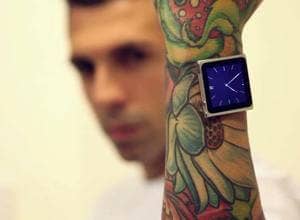Our Cyborg Future: Man Embeds Magnets In Wrist To Make Strapless Watch

Share
Like to keep track of time and enjoy music on your iPod nano, but can’t tolerate those cumbersome bands and straps? Just surgically implant magnets into your wrist and attach your nano – strap-free.
That’s what Dave Hurban did. The two posts embedded beneath his skin are attached to a pair of magnets each. Hurban measured out the location of the magnets so that they’d fit the nano precisely – the carpenter’s rule, “measure twice, cut once” being oh so important.
Hurban is calling his little bit of self-mutilation in the name of technology iDermal. A body piercer himself, he’s already had his fair share of piercings. So sticking the metallic posts, or “micro-dermal anchors” as he calls them, isn’t so drastic a fashion statement to him as it might be to most. But still, why’d he do it?
As he told Digital Times, because he “thought it would be cool.”
Be Part of the Future
Sign up to receive top stories about groundbreaking technologies and visionary thinkers from SingularityHub.


Judging from the comments on the YouTube video not many people are with Hurban on that one. But I’m going to go out on a limb here and say he probably doesn’t care what other people think. But take a closer look and you realize that the video has been viewed nearly 2 million times with almost a 2-to-1 ratio of "likes" to "dislikes." Is that because people admire Hurban's rebellious shrug of convention or does it speak to a broader movement towards body augmentation in general? We've already seen Skinput that turns your forearm and fingers into a control pad. The Pebble smartwatch is (surprisingly?) seriously popular, raising more than $10 million in its Kickstarter campaign. And Google Goggles will make it so uncool to ask for directions in the future. We're slowly and sometimes stylishly changing into cyborgs. Hopefully most of our augmentations won't involve as much blood as Hurban's.
[image credits: iDermal via YouTube]
[video credit: iDermal via YouTube]
images: iDermal
video: iDermal
Peter Murray was born in Boston in 1973. He earned a PhD in neuroscience at the University of Maryland, Baltimore studying gene expression in the neocortex. Following his dissertation work he spent three years as a post-doctoral fellow at the same university studying brain mechanisms of pain and motor control. He completed a collection of short stories in 2010 and has been writing for Singularity Hub since March 2011.
Related Articles

These Robots Are the Size of Single Cells and Cost Just a Penny Apiece

In Wild Experiment, Surgeon Uses Robot to Remove Blood Clot in Brain 4,000 Miles Away

A Squishy New Robotic ‘Eye’ Automatically Focuses Like Our Own
What we’re reading
